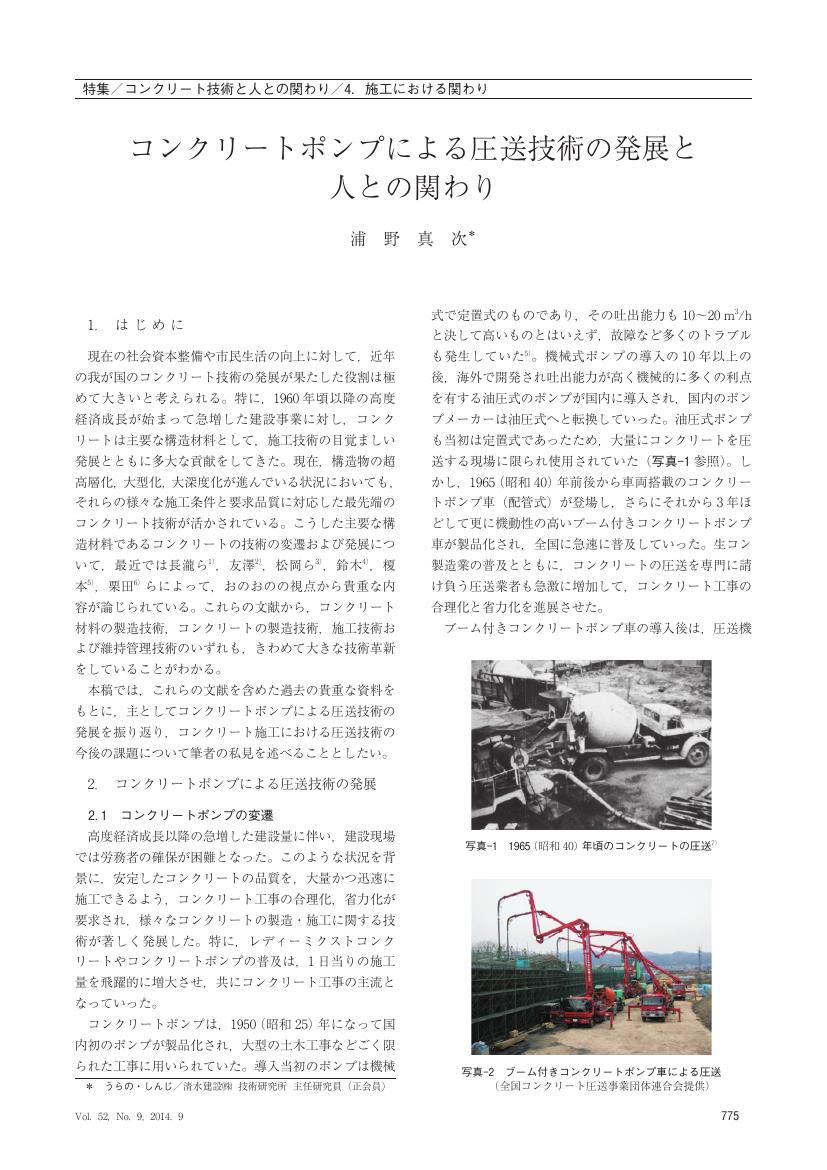2 0 0 0 OA コンクリートポンプによる圧送技術の発展と人との関わり
- 著者
- 浦野 真次
- 出版者
- 公益社団法人 日本コンクリート工学会
- 雑誌
- コンクリート工学 (ISSN:03871061)
- 巻号頁・発行日
- vol.52, no.9, pp.775-779, 2014 (Released:2015-09-01)
- 参考文献数
- 25
1 0 0 0 MPS法による高流動コンクリートのスランプフローシミュレーション
- 著者
- 山田 義智 上原 義己 崎原 康平 浦野 真次
- 出版者
- 日本建築学会
- 雑誌
- 日本建築学会構造系論文集 (ISSN:13404202)
- 巻号頁・発行日
- vol.85, no.771, pp.663-672, 2020
- 被引用文献数
- 5
<p> Concrete flow analysis is important, because it is possible to visualize how high fluidity concrete flows in the concrete placing form and in the gap between reinforcing bars.</p><p> In this study, MPS (Moving Particle Semi-implicit) method was used as a concrete flow analysis method. First, the flow of Bingham fluid between parallel plates was analyzed, and the validity of the analysis method was verified. Furthermore, the effectiveness of the proposed method was confirmed by comparing the results of slump flow analysis and test results. The research results of Kokado et al.<sup>3)</sup> were used for the rheological constants (yield value, plastic viscosity) of concrete used for slump flow analysis.</p><p> The results obtained in this study can be summarized as follows.</p><p> The flow of Bingham fluid between parallel plates was reproduced using the proposed MPS analysis. As the result, when the particle size was 20 mm, it was different from the theoretical value, and when the particle size was 10 mm, 5 mm, 2.5 mm, it agreed with the theoretical value.</p><p> The flow of Bingham fluid between parallel plates was reproduced by changing the value of the stress growth index m of the regularized Bingham model with m = 1 and 10,100. As a result, the theoretical value agreed well with the MPS analysis result in the fast range of flow velocity. In the range of slow flow, the MPS analysis results at the stress growth index m = 1 were faster than the theoretical solutions at the center of the parallel plate. Therefore, in order to represent the Bingham fluid, it is necessary to increase the value of the stress growth index m. In this study, the stress growth index m was set to 100 and used for MPS analysis.</p><p> The slump flow test was reproduced by MPS analysis using a regularized Bingham model with a particle size of 5 mm and a stress growth index of m = 100, assuming that the high fluidity concrete was a Bingham fluid. As the result, it was well reproduced in the range of slump flow value of about 500 mm, however, it tended to flow in the experimental result as the slump flow value increased from 600 mm to 700 mm.</p><p> When the slump flow value is less than 600 mm, the spread curve of the flow can be reproduced within the range of the rheological constant within the 95% upper and lower limit prediction interval. However, at the slump flow value of 700 mm, the experimental value flows more than the analytical result using the yield value of 95% lower limit. According to the results of the finite difference analysis in the literature (4), at a slump flow value of over 600 mm, the measured value tends to flow more than the analytical result. Therefore, if the slump flow value exceeds 600 mm, the yield value by the lifting sphere viscometer test may have been evaluated higher. Furthermore, high fluidity concrete with a slump flow value exceeding 600 mm may exhibit non-Bingham properties in the low shear rate region.</p>
1 0 0 0 OA フレッシュコンクリートのレオロジー定数推定に関する基礎的研究
- 著者
- 山田 義智 赤嶺 糸織 伊波 咲子 浦野 真次
- 出版者
- 一般社団法人 セメント協会
- 雑誌
- セメント・コンクリート論文集 (ISSN:09163182)
- 巻号頁・発行日
- vol.66, no.1, pp.661-668, 2013-02-25 (Released:2013-12-02)
- 参考文献数
- 6
- 被引用文献数
- 1 2
本研究では、ペーストからモルタルさらにコンクリートへと展開する新たな粘度式を提案した。そして、この粘度式を用いて、ペースト、モルタル、コンクリートのレオロジー定数を調合(配合)から推定する手法を示した。ここで、提案手法で求めたペーストとモルタルのレオロジー定数の有効性については、既往の実験結果との関係を比較・検討することで確認した。一方、コンクリートのレオロジー定数の有効性については、提案手法で求めたレオロジー定数を入力値として有限要素法でスランプシミュレーションを行い、実測結果と比較することで確認を行った。
